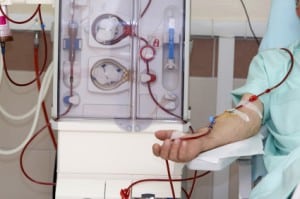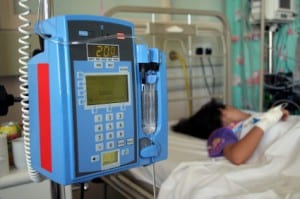Medial claviculectomy for the treatment of recalcitrant central venous stenosis

Medial claviculectomy is an effective treatment of recalcitrant central venous stenosis of the thoracic outlet” Auyang et al 92019). Abstract: OBJECTIVE: Outflow tract stenosis is the leading cause of hemodialysis access loss. Many lesions are highly resistant to endovascular treatment, necessitating open surgical intervention. We present our experience using medial claviculectomy for treatment of recalcitrant […]
Pharmacokinetic effects of endotracheal, intraosseous, and intravenous epinephrine

This study compared the maximum concentration (Cmax), time to maximum concentration (Tmax), plasma concentration over time, return of spontaneous circulation (ROSC), time to ROSC, and odds of ROSC of epinephrine administered by the endotracheal (ETT), intraosseous (IO), and intravenous (IV) routes in a swine TCA model” Burgert et al (2019). Abstract: Introduction: Limited prospective data […]
Point-of-care laboratory analyses of intraosseous, arterial and central venous samples

The aims of this study were to compare the intraosseous (IO), arterial and central venous POC values during CA and CPR and to see how the CPR values reflect the pre-arrest state” Jousi et al 92019). Abstract: INTRODUCTION: Screening and correcting reversible causes of cardiac arrest (CA) are an essential part of cardiopulmonary resuscitation (CPR). […]
Advantages and disadvantages of vascular access choice in hemodialysis

We present the advantages and disadvantages of each vascular access, as well as their main local (thrombosis, infection, steal syndrome) and systemic (heart failure, pulmonary hypertension) complications, which may also be encountered by primary care physicians” Pivin et al (2019). Abstract: The most frequent dialysis modality in Switzerland is hemodialysis. Patients need a proper vascular […]
Blood culture result profile and antimicrobial resistance pattern

The objective of this study was to evaluate patterns of bacterial isolates and local antimicrobial susceptibility patterns in neonatal sepsis” Sorsa et al (2019). Abstract: Background: Antimicrobial resistance is one of the major public health emergencies worldwide, and this trend didn’t spare developing countries like Ethiopia. The objective of this study was to evaluate patterns […]
Implementation of infection prevention and control in acute care hospitals in Mainland China

The objective of this systematic review was to assess adoption and implementation of the three areas issued by the “National Health Commission of the People’s Republic of China” in acute-care hospitals in Mainland China, and to compare the findings with the key and core components on effective IPC, issued by the European Centre for Disease […]
Evaluation of an emergency department to OPAT program for cellulitis

Emergency department (ED) patients with non-purulent skin and soft tissue infections (SSTIs) requiring intravenous antibiotics may be managed via outpatient parenteral antibiotic therapy (OPAT)” Yadav et al (2019). Abstract: Objective: Emergency department (ED) patients with non-purulent skin and soft tissue infections (SSTIs) requiring intravenous antibiotics may be managed via outpatient parenteral antibiotic therapy (OPAT). Prospective […]
Home self-administration of intravenous antibiotics

The key behavioural determinants emerging as encouraging patients to self-administer intravenous antibiotics were the perceptions of being sufficiently knowledgeable, skilful and competent and that self-administration afforded the potential to work while administering treatment” Tonna et al (2019). Abstract: OBJECTIVES: This study aimed to use a theoretical approach to understand the determinants of behaviour in patients […]
Outpatient parenteral antimicrobial therapy in vulnerable patients

Outpatient parenteral antimicrobial therapy (OPAT) programs can provide high-value care but may be challenging in people who inject drugs (PWID) and homeless individuals” Beieler et al (2019). Abstract: Outpatient parenteral antimicrobial therapy (OPAT) programs can provide high-value care but may be challenging in people who inject drugs (PWID) and homeless individuals. We conducted a single-center, […]
Patient confidence in speaking up about breakdowns in care

To assess patient comfort speaking up about problems during hospitalisation and to identify patients at increased risk of having a problem and not feeling comfortable speaking up” Fisher et al (2019). Abstract: Objective: To assess patient comfort speaking up about problems during hospitalisation and to identify patients at increased risk of having a problem and […]
Stopping treatment when a clinical procedure goes wrong

When patients enter the hospital, they entrust clinicians to push a red button if they sense something wrong. But patients themselves, increasingly championed as ‘members of the team’ and ‘co-producers’ of health, are not always given a button nor taught how to use it” Bell and Martinez (2019). Extract: “When patients enter the hospital, they […]
Factors affecting the first attempt success rate of intravenous cannulation

To determine the factors affecting the first-attempt success of peripheral intravenous catheter (PIVC) placement in older emergency department patients” Yalçınlı et al (2019). Abstract: AIMS AND OBJECTIVES: To determine the factors affecting the first-attempt success of peripheral intravenous catheter (PIVC) placement in older emergency department patients. BACKGROUND: In older patients who require intravenous treatment, establishing […]
Prolonged use of peripherally inserted central venous catheters in children

PICCs in children with intestinal failure have similar complication rates to Broviacs®. Use of tunneled PICCs and increasing experience with this vascular access method may allow it to realize its potential advantages” LaRusso et al (2019). Abstract: PURPOSE: Prolonged central vascular access is a source of significant morbidity in children with intestinal failure (IF). In […]
Central venous line-related thromboembolism in children

However, up to half of the children with acute lymphoblastic leukaemia will develop asymptomatic central venous line-related thromboembolism” Jarvis et al (2019). Abstract: Children with acute lymphoblastic leukaemia face increased risks of thromboembolism, and major risk factors for this serious treatment-related toxicity are central venous lines, asparaginase and steroids. Central venous lines have become standard […]
Review of ultrasound-guided vascular access in critical illness

Over the past two decades, ultrasound (US) has become widely accepted to guide safe and accurate insertion of vascular devices in critically ill patients. We emphasize central venous catheter insertion, given its broad application in critically ill patients, but also review the use of US for accessing peripheral veins, arteries, the medullary canal, and vessels […]
Rare variation of the hemiazygos vein draining into the persistent left superior vena cava

During an educational dissection of a 72-year-old Chinese male cadaver, the hemiazygos vein (HAV) coursing the left side that drains into the persistent left superior vena cava was observed” Liu et al (2019). Abstract: During an educational dissection of a 72-year-old Chinese male cadaver, the hemiazygos vein (HAV) coursing the left side that drains into […]
Tissue adhesives to secure peripheral intravenous catheters

In this study, we aimed to test that addition of tissue adhesive to the insertion site of peripheral intravenous catheters (PIVC) in the emergency department (ED) would reduce the device failure rate at 6 h and 24 h following insertion” Özkula et al (2018). Abstract: INTRODUCTION: Peripheral venous catheterization is one of the most used medical procedures […]
Skin disinfection prior to central venous catheter insertion in preterm neonates

This study will inform the feasibility and design of the first randomised controlled trial to examine the safety and efficacy of alcohol-based versus aqueous-based chlorhexidine antiseptic formulations for skin disinfection prior to percutaneous central venous catheterisation in preterm neonates” Clarke et al (2019). Abstract: INTRODUCTION: Catheter-related sepsis is one of the most dangerous complications of […]
How to determine correct depth of central venous catheter insertion

This study aimed to determine a simple and practical method to predict the ideal CVC insertion depth after ultrasound-guided right internal jugular, or left or right supraclavicular puncture in pediatric patients” Yamamoto and Schindler (2019). Abstract: BACKGROUND: Several formulae or methods are reported to predict the ideal central venous catheter (CVC) insertion depth. However, they […]
Increased risk of Staphylococcus aureus bacteremia in hemodialysis

Staphylococcus aureus bacteremia (SAB) is a high-risk infection and feared complication related to hemodialysis. This study aimed to investigate incidence and risk factors for SAB depending on hemodialysis access type” Chaudry et al (2019). Abstract: INTRODUCTION: Staphylococcus aureus bacteremia (SAB) is a high-risk infection and feared complication related to hemodialysis. This study aimed to investigate […]
Infection prevention and control programmes in long-term care facilities

The purpose of this systematic review was to review and analyse the effectiveness and the components of IPC programmes in LTCFs for older adults” Lee et al (2019). Abstract: Background: Infection prevention and control (IPC) is a measure to prevent healthcare-associated infections in healthcare settings. There is limited evidence of the effectiveness of IPC programmes […]
Cost analysis of haemodialysis catheter related bloodstream infection

Catheter related bloodstream infections (CRBSI) represent a complication that often requires hospitalization and the use of economic resources. In Italy, there is no literature that considers the costs of CRBSI for tunneled catheters (CVCt)” Mandolfo et al (2019). Abstract: Catheter related bloodstream infections (CRBSI) represent a complication that often requires hospitalization and the use of […]
Immediate-term cognitive impairment following IV chemotherapy

This study utilized the psychomotor vigilance test (PVT) and trail-making test B (TMT-B) to assess cognitive impairment immediately post-chemotherapy” Khan et al (2019). Abstract: BACKGROUND: Cognitive impairment is commonly reported in patients receiving chemotherapy, but the acuity of onset is not known. This study utilized the psychomotor vigilance test (PVT) and trail-making test B (TMT-B) […]
Risk factors for non-central line-associated bloodstream infection

This study was performed to investigate the clinical impacts and risk factors for N-CLABSI in intensive care unit (ICU) patients” Zhu et al (2019). Abstract: BACKGROUND: Most of the previous studies focused on central line-associated bloodstream infection (CLABSI), while non-central line-associated bloodstream infection (N-CLABSI) was poorly studied. This study was performed to investigate the clinical […]
Impact of discontinuation of contact precautions on CLABSI rates

We investigated the impact of discontinuation of contact precautions for methicillin-resistant Staphylococcus aureus and vancomycin-resistant Enterococcus infected or colonized patients on central-line associated bloodstream infection rates” Godbout et al (2019). Abstract: We investigated the impact of discontinuation of contact precautions for methicillin-resistant Staphylococcus aureus and vancomycin-resistant Enterococcus infected or colonized patients on central-line associated bloodstream […]
The Angel catheter for the prevention of pulmonary embolism

The Angel Catheter device is a central venous catheter combined with an inferior vena cava filter inserted at the bedside for pulmonary embolism prevention. Our review examines the role of this device, safety, efficacy and the limitations it presents” Achaibar et al (2019). Abstract: Pulmonary embolism is common in critical care patients and carries significant […]
PICC placement using an ultrasound and electrocardiogram-guided system

To assess the cost-effectiveness of peripherally inserted central catheter (PICC) placements using an ultrasound and electrocardiogram-guided system versus external measurements and confirmatory chest X-rays (CXRs)” Keller et al (2019). Abstract: PURPOSE: To assess the cost-effectiveness of peripherally inserted central catheter (PICC) placements using an ultrasound and electrocardiogram-guided system versus external measurements and confirmatory chest X-rays […]
Ethanol lock therapy for CLABSI prevention

Ethanol lock therapy (ELT) has been reported as being effective in preventing central line-associated bloodstream infection (CLABSI)” Lopes et al (2019). Abstract: BACKGROUND: Ethanol lock therapy (ELT) has been reported as being effective in preventing central line-associated bloodstream infection (CLABSI) in tunneled (or long-term) central venous catheters (CVCs). To the best of our knowledge, no […]
Case study describes hemodialysis catheter-induced bradycardia

We describe a case of recurrent symptomatic intra-dialytic bradycardia due to abnormal positioning of CVC that resolved after the repositioning of the catheter” Sitaula et al (2019). Abstract: Sudden cardiac death (SCD) is reported as leading cause of death in patients on chronic hemodialysis. Arrhythmias are proposed to be a major predisposing factor for SCD. […]
Effects of chloride content of IV crystalloid solutions in critically ill patients

Intravenous crystalloid solutions are administered commonly for critically ill patients. We performed this meta-analysis of randomized trials with trial sequential analysis (TSA) to evaluate effects of chloride content of intravenous crystalloid solutions on clinical outcomes among critically ill adult patients” Xue et al (2019). Abstract: Background: Intravenous crystalloid solutions are administered commonly for critically ill […]

